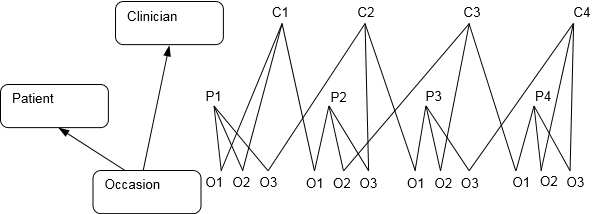Non-Hierarchical Structures
So far all our examples have been of an exact nesting of a lower level unit in one and only one higher-level unit. That is, we have been dealing with strict hierarchies. But social reality can be more complicated than that! In fact it turns out that we need two non-hierarchical structures which, in combination with strict hierarchies, will be able to deal with all the different types of designs, realities and research questions that we will meet:
- Cross-classified structures
- Multiple membership structures
The existence of these non-hierarchical structures accounts for our preference for the term ‘multilevel models’ in preference to the more limited ‘hierarchical models’.
Cross-classified Structures
As an example, we consider a health setting with repeated measures on patients but patients being assessed by different clinicians at different times.This is depicted in below where, for example, patient 1 is seen by clinician 1 at occasions 1 and 2 then by clinician 2 at occasion 3.

Cross Classified Repeated Measures Data of follow-up visit by patient and clinician
In this setting, we cannot nest each patient to a single physician. The follow-up visits are still nested within a single patient, but they are withing multiple physicians. Here the patients and physicians are cross-classified.
| Classifications or levels | Response | Explanatory variables | |||
|---|---|---|---|---|---|
| Occasion k |
Patient j |
Clinician i |
Cholesterol level (ijk) |
Clinician type i |
Patient gender j |
| 1 | 1 | 1 | 3.5 | Doctor | M |
| 2 | 1 | 1 | 3.8 | Doctor | M |
| 3 | 1 | 2 | 3.4 | Nurse | M |
| 1 | 2 | 1 | 4.1 | Doctor | F |
| 2 | 2 | 3 | 4.8 | Nurse | F |
| 3 | 2 | 2 | 4.8 | Nurse | F |
| 1 | 3 | 2 | 6.9 | Nurse | F |
| 2 | 3 | 3 | 6.2 | Nurse | F |
| 3 | 3 | 4 | 6.5 | Doctor | F |
| 1 | 4 | 3 | 5.1 | Nurse | M |
| 2 | 4 | 4 | 5.3 | Doctor | M |
| 3 | 4 | 4 | 5.5 | Doctor | M |
Multiple Memebership Structures
We now come to our final structure, a multiple membership structure, in which the atomic units are seen as nested within more than one unit from a higher-level classification. A simple example, would be in health outcomes, where patients are treated by multiple nurses, so patients would be multiple members of nurses. We can still view this as a strict hierachy with Nurses at level two and patients at level one, but now patients can be nestd under more that one nurse. In this case, weights can be used to measure the proportion of times that a given patient spends with the nurses that have treated them.
Multiple Memebershipe of Patients within Nurses
Combining Multiple Structures
It is possible to combine the three types of structure (strict hierarchy, cross-classification and multiple membership) to reflect social reality and the research designs employed to study it. Consider the structure depicted below.

An example of a non-hierarchical structure relating patients to nurses, hospitals and general practicioners
In this example,
- Patients are multiple members of nurses
- Nurses are nested within hospitals
- Patients are nested within GPs
- Nurses are crossed with GPs
- Hospitals are crossed with GPs